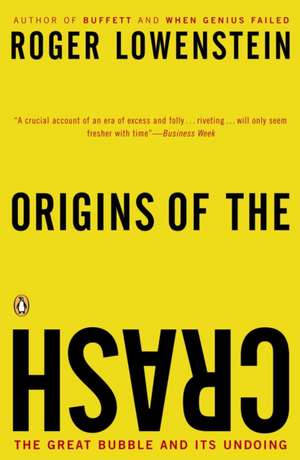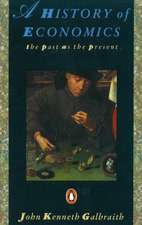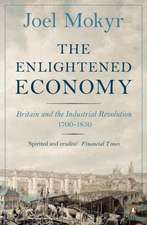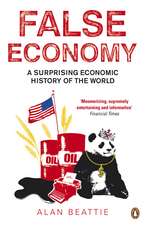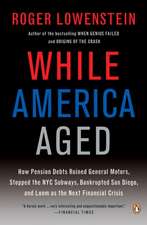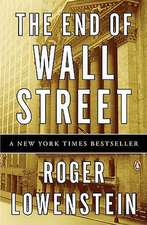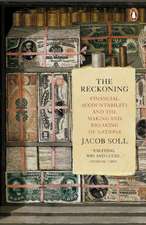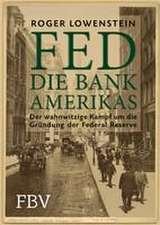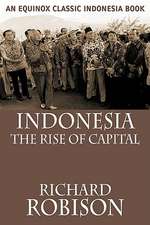Origins of the Crash: The Great Bubble and Its Undoing
Autor Roger Lowensteinen Limba Engleză Paperback – 30 noi 2004 – vârsta de la 18 ani
With his singular gift for turning complex financial events into eminently readable stories, Roger Lowenstein lays bare the labyrinthine events of the manic and tumultuous 1990s. In an enthralling narrative, he ties together all of the characters of the dot-com bubble and offers a unique portrait of the culture of the era. Just as John Kenneth Galbraith’s The Great Crash was a defining text of the Great Depression, Lowenstein’s Origins of the Crash is destined to be the book that will frame our understanding of the 1990s.
Preț: 132.57 lei
Nou
Puncte Express: 199
Preț estimativ în valută:
25.37€ • 26.54$ • 21.07£
25.37€ • 26.54$ • 21.07£
Carte disponibilă
Livrare economică 13-27 martie
Preluare comenzi: 021 569.72.76
Specificații
ISBN-13: 9780143034674
ISBN-10: 0143034677
Pagini: 288
Dimensiuni: 145 x 201 x 16 mm
Greutate: 0.25 kg
Editura: Penguin Books
ISBN-10: 0143034677
Pagini: 288
Dimensiuni: 145 x 201 x 16 mm
Greutate: 0.25 kg
Editura: Penguin Books
Recenzii
"The perfect epitaph to an era of monumental avarice and folly on Wall Street. This is financial history at its best." —Ron Chernow
"A crucial account of an era of excess and folly...riveting...will only seem fresher with time." —BusinessWeek
"A crucial account of an era of excess and folly...riveting...will only seem fresher with time." —BusinessWeek
Notă biografică
Roger Lowenstein, author of the bestselling Buffett: The Making of an American Capitalist and When Genius Failed: The Rise and Fall of Long-term Capital Management, reported for the Wall Street Journal for more than a decade and wrote the Journal’s stock market column “Heard on the Street” and also its “Intrinsic Value” column. He now contributes articles and reviews to the Journal and the New York Times Magazine and is a columnist for SmartMoney Magazine. He lives in Westfield, New Jersey.
Extras
In the 1970s, a candidate for president advanced the novel proposition that the money in the Social Security system should be funneled into, of all places, the stock market. The candidate’s name was Ronald Reagan. The incumbent president, Gerald Ford, had a good deal of fun with this evidently zany proposition. “I am not sure a lot of people would think it was a very good place to invest funds over the longer period of time,” Ford declared. His advisers had no trouble tarring the idea as kooky. The president likened it to “something dragged out of the sky.” If not certifiably alien, then it might even be—perish the thought—an example of “wild-eyed socialism,” which was no doubt something worse.
Ford did not have to explain why he thought the stock market was not a safe place “over the longer period of time.” Stocks were considered simply too risky. Indeed, in 1976, the market was no higher than its level of eleven years before. Adjusted for inflation, the picture was far worse: The purchasing power of the average stock had fallen by two thirds. Even over the longer sweep of a half century, stocks had managed a gain of only 3.5 percent a year, so that people thought of the stock market as a place that went upward a little but sideways mostly, with wrenching nosedives along the way. Indeed, the number of Americans who owned stock would actually fall during the seventies by seven million.
Such grim statistics were reflected in a certain distance between the market and people’s ordinary lives. Many newspapers carried at most a single account of the previous day’s action on Wall Street, and television barely covered it at all. Today, at my daughter’s middle school in New Jersey, an investing club is busily educating future market wizards, but in the seventies, through four years on an Ivy League campus, I didn’t hear a mention of the stock market. Professors spoke darkly of America’s economic interests, but if any of those interests happened to be corporations with publicly traded shares, it was a detail that went unspoken.
Unlike in the nineties, when people would become accustomed to faithfully adding a little bit to mutual funds, rain or shine, every month, in the seventies, they withdrew a little bit, month after month, and they did so for eight long years. For Wall Street it was one long night, one long depression. Even the pros who managed pension funds were little more interested in stocks than my professors were. By 1979, of the money managed by pension funds, 90 percent was invested not in stocks but in bonds, bills and cash, which was practically like stuffing it under a mattress. That summer, BusinessWeek sized up America’s non-love affair with the stock market in a morbid, and instantly famous, cover story—“The Death of Equities.”
But equities were not dead, only dormant. And the renaissance began in short order. Three months after the article, mutual funds—finally—took in more money from investors than they redeemed. The net addition was a trifle—a mere $12 million. But deep in the giant furnace room where the economy is engineered, a long-stuck wheel had emitted a creak, shaken off its cobwebs, and, finally, turned. People were buying stocks.
Over time, this little shift, this rediscovered habit that would ripen into a passion, would affect far more than the Dow Jones average. When investors awoke, executives found that they, too, inhabited a different world. The rules soon changed for auditors and analysts and ordinary savers as well—an entire culture was retailored. By the late 1990s, America would become more sensitive to markets, more ruled by markets, than any country on earth.
This was the culture that would lead to prosperity and also to Enron. Markets would become virtually sovereign—unchecked by corporate watchdogs or by government. Distortions would follow, and with the temptation of wealth that distortions brought, corruption. But in the late seventies, no one was thinking of markets as powerful or pervasive. The country’s problem was that it was too insensitive, too unresponsive, to markets. They were not hyperactive or feverish then, but—potentially—a cure.
Ford did not have to explain why he thought the stock market was not a safe place “over the longer period of time.” Stocks were considered simply too risky. Indeed, in 1976, the market was no higher than its level of eleven years before. Adjusted for inflation, the picture was far worse: The purchasing power of the average stock had fallen by two thirds. Even over the longer sweep of a half century, stocks had managed a gain of only 3.5 percent a year, so that people thought of the stock market as a place that went upward a little but sideways mostly, with wrenching nosedives along the way. Indeed, the number of Americans who owned stock would actually fall during the seventies by seven million.
Such grim statistics were reflected in a certain distance between the market and people’s ordinary lives. Many newspapers carried at most a single account of the previous day’s action on Wall Street, and television barely covered it at all. Today, at my daughter’s middle school in New Jersey, an investing club is busily educating future market wizards, but in the seventies, through four years on an Ivy League campus, I didn’t hear a mention of the stock market. Professors spoke darkly of America’s economic interests, but if any of those interests happened to be corporations with publicly traded shares, it was a detail that went unspoken.
Unlike in the nineties, when people would become accustomed to faithfully adding a little bit to mutual funds, rain or shine, every month, in the seventies, they withdrew a little bit, month after month, and they did so for eight long years. For Wall Street it was one long night, one long depression. Even the pros who managed pension funds were little more interested in stocks than my professors were. By 1979, of the money managed by pension funds, 90 percent was invested not in stocks but in bonds, bills and cash, which was practically like stuffing it under a mattress. That summer, BusinessWeek sized up America’s non-love affair with the stock market in a morbid, and instantly famous, cover story—“The Death of Equities.”
But equities were not dead, only dormant. And the renaissance began in short order. Three months after the article, mutual funds—finally—took in more money from investors than they redeemed. The net addition was a trifle—a mere $12 million. But deep in the giant furnace room where the economy is engineered, a long-stuck wheel had emitted a creak, shaken off its cobwebs, and, finally, turned. People were buying stocks.
Over time, this little shift, this rediscovered habit that would ripen into a passion, would affect far more than the Dow Jones average. When investors awoke, executives found that they, too, inhabited a different world. The rules soon changed for auditors and analysts and ordinary savers as well—an entire culture was retailored. By the late 1990s, America would become more sensitive to markets, more ruled by markets, than any country on earth.
This was the culture that would lead to prosperity and also to Enron. Markets would become virtually sovereign—unchecked by corporate watchdogs or by government. Distortions would follow, and with the temptation of wealth that distortions brought, corruption. But in the late seventies, no one was thinking of markets as powerful or pervasive. The country’s problem was that it was too insensitive, too unresponsive, to markets. They were not hyperactive or feverish then, but—potentially—a cure.
Descriere
This definitive account of the dot-com boom and bust is offered by "one of the best financial journalists there is" ("The New York Times Book Review").
